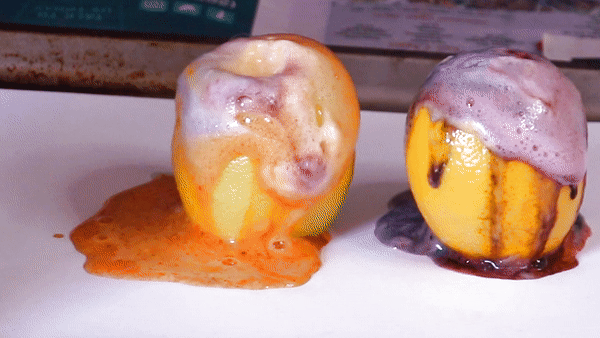Summer School with Live Science: Lemon volcanoes

This Friday (June 11), we will explore the eruptive realm of acid-base chemistry in our new kids video series: Summer School with Live Science.
In this week's installment, Live Science producer, Diana Whitcroft, will demonstrate the reaction between sodium bicarbonate (baking soda) and citric acid (lemon juice, in this case). This fun experiment is a great way to introduce young minds to the world of chemistry.
Every Friday at 3 p.m. EDT (12 p.m. PDT), Diana will host Summer School With Live Science, which you can find live on Live Science's Facebook, YouTube and Twitter pages. Every week, the series will explore a different field of STEM (science, technology, engineering and mathematics) through simple hands-on experiments that you and your child can follow along with at home.
Disclaimer: It is strongly advised that all science experiments, recipes and methods be attempted only under adult supervision. Adults are required to handle or assist with any potentially harmful utensils and ingredients. Always wash hands thoroughly after trying any experiment. Avoid touching your face and eyes when performing any experiments, and if possible, wear glasses or safety goggles. Do not ingest any of the ingredients during or after performing this experiment.
Lemon Volcanoes: Materials
Age Range: 5-10 years
- Tray or Cookie sheet
- Paper (optional)
- Lemons
- Cutting knife
- Popsicle stick
- Spoon
- Food coloring
- Dish soap
- Baking soda
Step One: Prep Your Work Station
Place your tray on a surface that has been well-covered with newspaper. Optional: Place paper on your tray; this is where you'll be erupting your volcanoes and if the paper catches the colorful liquid, you can turn it into artwork.
Step Two: Ready Your Lemon
Have an adult cut a small portion of the bottom off the lemon so that it stands upright. Then, cut off the top of the lemon, exposing the inside pulp and juice. Using your popsicle stick, mash the inside of the lemon so that the "meat" or fleshy interior is completely pushed down and the lemon is filled with mostly juice. Be careful not to puncture the lemon rind.
Sign up for the Live Science daily newsletter now
Get the world’s most fascinating discoveries delivered straight to your inbox.
Step Three: Choose a Color
Squeeze a few drops of your food coloring into your lemon. The amount of food coloring you use is dependent on the size of your lemon and how much juice it yields. Small lemons with very little juice: 2-3 drops. Large lemons with a lot of juice: 4-5 drops. Try different color combinations and see what comes out! You can even erupt two or three lemons at a time for a tie-dye effect on your paper. Then, give a good squirt of dish soap into your lemon.
Step Four: Erupt Your Volcano
Using your spoon, sprinkle into your lemon a few teaspoons of baking soda. Again, depending on the size of your lemon, you'll need to adjust the amount. Small lemons with little juice: 2-3 tsp. Large lemons with a lot of juice: 4-5 tsp. Right away, you should see bubbling and fizzing, but it is likely that you'll need to use your spoon or popsicle stick to better mix the juice and baking soda. Your lemons will now start to overflow with colorful bubbles.
Document this experience and send images to us either on social media or to community@livescience.com. We'd love to see your results so that we can feature them in our photo gallery!
Step Five: Paint!
Now that the explosive fun is over, it's time to get creative. Using your hands, a paint brush or even sponges, create your own works of art from the colorful liquid left behind on the paper. Simply remove your lemons and go to town! Be sure not to over-paint your paper. Combining your colors too much will turn your colorful canvas into a big grey blob, (unless of course you really like the color grey!).
The science behind lemon volcanoes
When the baking soda was added to the lemon juice, it bubbled and foamed. That is because when sodium bicarbonate (baking soda) and citric acid (lemon juice) are combined, they react by forming carbon dioxide gas as well as a chemical compound called sodium citrate. It's the carbon dioxide that causes all those bubbles (remember CO2 is the gas that makes your can of soda or seltzer water fizz). We know that carbon dioxide is the primary gas we exhale when breathing. It occurs naturally in Earth's atmosphere and is emitted by natural sources like geysers (and volcanoes) as well as industrial processes.
Sodium citrate is the sodium derived from citric acid. It is used in a variety of everyday items. It is used as an anticoagulant for blood products, as well as an acidity regulator in food.

Diana Whitcroft joined Live Science and Space.com in the fall of 2017. After receiving a B.F.A in Directing & Producing for Film and Television, she worked as a video editor at CNBC in Englewood Cliffs, New Jersey. During her time in broadcast television, she created a role for herself as a "Science Preditor" in which she produced and edited content specific to the business aspect of the private sector space industry. Searching for a deeper role within the science journalism sector, Diana came to Space.com and Live Science as a Social Media Producer, handling multimedia content for all social pages. She is a hardcore trekkie, comic nerd, environmentalist, video-gamer and all-around space geek.
Most Popular

